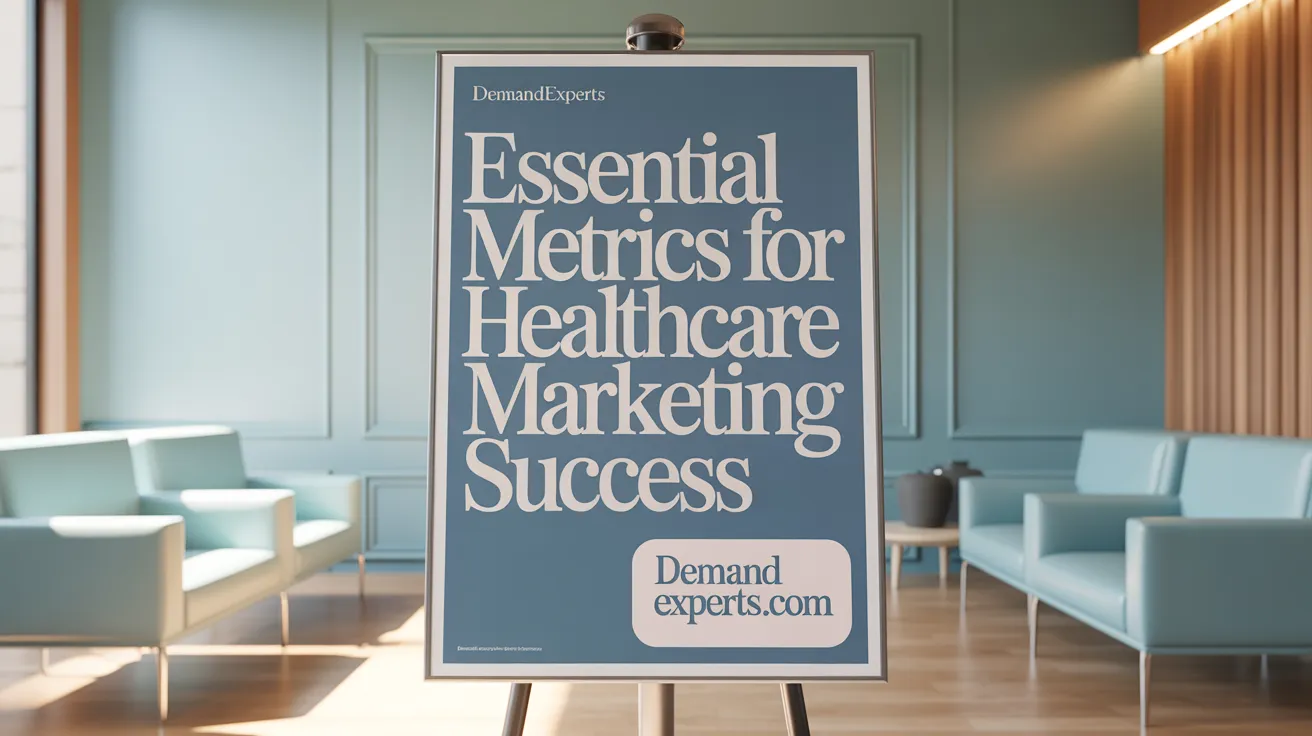Introduction to ROI in Healthcare Marketing
Definition of ROI in Healthcare Marketing
Return on Investment (ROI) in healthcare marketing measures the profitability and effectiveness of marketing efforts by comparing the net revenue generated to the costs incurred. The standard formula used is (Net Revenue – Marketing Spend) / Marketing Spend, providing a quantifiable indicator of marketing success.
Importance of ROI Measurement
Measuring ROI is critical for healthcare organizations to justify marketing budgets, allocate resources effectively, and optimize strategies for patient acquisition and retention. It enables marketers to demonstrate value through concrete financial outcomes and aligns marketing investments with organizational goals.
Unique Challenges in Healthcare Marketing ROI
Healthcare marketing ROI measurement is complex due to non-linear patient journeys, multiple engagement touchpoints across various platforms, and strict privacy regulations like HIPAA which restrict data access. Unlike traditional retail sectors, the delayed nature of patient conversions and fragmentation of data across systems such as EHRs and CRMs further complicate accurate tracking. Advanced tools and multi-touch attribution models are essential to connect marketing campaigns to real patient actions such as appointment bookings and treatment adherence, ensuring more precise ROI evaluation.
Key Metrics to Measure ROI in Healthcare Marketing

What are the essential metrics for assessing ROI in healthcare marketing?
Healthcare marketing ROI evaluation depends on several critical metrics that collectively measure both reach and profitability. Audience quality is fundamental, ensuring marketing campaigns target potential patients most likely to engage and convert. Tracking lead generation at various funnel stages—acquisition, engagement, and conversion—helps gauge campaign efficiency in moving patients through the decision-making process.
Conversion rate is a direct indicator of success, reflecting the percentage of targeted patients who complete desired actions like appointment bookings or form submissions. Closely linked is the patient acquisition cost (also called cost-per-acquisition or CPA), which should be analyzed by individual marketing channels and campaigns using attribution tools to optimize spending.
Consumer engagement metrics, such as clicks, shares, comments, and calls to the call center, provide insight into patient interest and help refine marketing strategies over time. Lastly, contribution margin—calculated as revenue minus variable costs—is key to understanding campaign profitability. This metric is significantly influenced by payer mix, with patients covered by commercial insurance often yielding higher reimbursement rates and thus greater ROI compared to those covered by Medicare or Medicaid.
By consistently monitoring these metrics with data-driven dashboards and analytics, healthcare marketers can prove the value of their campaigns, optimize resource allocation, and guide future investments for sustainable patient growth and organizational success.
Calculating and Interpreting Marketing ROI in Healthcare

How is ROI calculated for healthcare marketing?
ROI in healthcare marketing is calculated using the formula: (Total Revenue - Campaign Costs) ÷ Campaign Costs. This provides a clear percentage return on the investment, enabling healthcare organizations to evaluate campaign profitability effectively.
What role does lifetime patient value (LTV) play in measuring ROI?
Incorporating Lifetime Patient Value (LTV) is crucial for understanding the long-term revenue potential from acquired patients. For example, pain clinics estimate an average LTV around $6,700 per patient, emphasizing the importance of investments that generate lasting patient relationships, not just immediate conversions.
What are some case studies illustrating healthcare marketing ROI multiples?
Multiple case studies demonstrate the effectiveness of well-executed healthcare marketing campaigns:
- A weight loss campaign achieved an ROI of approximately 15 times the initial investment.
- Urgent care centers have reported ROI averages near 44 times the marketing spend.
- A primary care clinic grew daily patient volume from 30 to over 30 patients per day primarily through online advertising.
These examples underscore digital strategies like SEO, PPC, and online presence optimization as powerful drivers of measurable growth.
How do attribution models and data-driven allocation enhance ROI measurement?
Attribution models in healthcare marketing allocate acquisition costs precisely across marketing channels and campaigns, facilitating identification of the most efficient tactics. Data-driven allocation ensures budget optimization by emphasizing high-performing channels. Multi-touch attribution captures the full patient journey, overcoming challenges posed by fragmented data and privacy regulations such as HIPAA compliance in marketing analytics.
Healthcare Privacy Platforms have emerged as critical tools, securely bridging data silos (e.g., between EHRs and marketing systems) to connect marketing actions with patient outcomes like appointment bookings. This integration allows accurate Customer Acquisition Cost (CAC) calculations, further refining ROI insights and guiding strategic resource allocation.
By combining these approaches, healthcare marketers can reliably calculate and interpret ROI, justify their budgets, and continuously optimize campaigns for sustained patient growth and revenue improvement.
Data Integration and Privacy Compliance in ROI Tracking

Challenges of Fragmented Healthcare Data
Healthcare marketing ROI measurement is complicated by the fragmentation of data across multiple systems, including Electronic Health Records (EHRs), Customer Relationship Management (CRM) platforms, and marketing tools. This fragmentation limits visibility into the patient journey and hinders the ability to connect marketing efforts directly with patient outcomes. For more details, see Unlocking ROI in Healthcare: Bridging Data Gaps in Healthcare Marketing and Tracking ROI in Healthcare Marketing.
Impact of HIPAA and Privacy Regulations
Strict privacy laws, particularly the Health Insurance Portability and Accountability Act (HIPAA), impose significant constraints on accessing and sharing patient data. These regulations protect patient information but also complicate the linkage of marketing data to clinical outcomes, making ROI measurement more difficult. Learn more about HIPAA compliance in marketing analytics and the impact of HIPAA on healthcare marketing.
Use of Healthcare Privacy Platforms
To address data privacy and integration challenges, healthcare organizations are adopting Healthcare Privacy Platforms. These platforms create secure and compliant 'bridges' between disparate datasets, allowing marketers to access key downstream data such as appointment bookings and attendance while maintaining HIPAA compliance. Such solutions enable more accurate and actionable marketing analytics. More about Healthcare Privacy Platforms for Secure Data Access.
Connecting EHR and Marketing Data for CAC Calculation
By integrating EHR data with marketing performance metrics, healthcare marketers can precisely calculate metrics like Customer Acquisition Cost (CAC). CAC measurement is vital for understanding the effectiveness of various campaigns and channels. This integration supports optimized ad spend allocation and more robust ROI reporting, enabling healthcare organizations to justify marketing investments and improve patient acquisition strategies. Explore Calculating Customer Acquisition Cost in Healthcare and How to Track ROI on Your Healthcare Marketing Campaigns.
Advanced Techniques to Enhance ROI Measurement

What advanced methods improve accuracy and efficiency in measuring healthcare marketing ROI?
Healthcare marketing ROI measurement has evolved with the adoption of advanced techniques that provide more precise and actionable insights.
Multi-touch attribution and closed-loop reporting are fundamental in capturing the complete patient journey. Unlike single-touch models, multi-touch attribution recognizes every marketing interaction a patient experiences before converting. This comprehensive view enables marketers to understand the contribution of all channels and campaigns, leading to more accurate ROI calculations and better budget allocation.
AI and automation further enhance measurement accuracy and operational efficiency. AI analyzes large datasets to identify high-impact touchpoints, predict patient behaviors, and optimize campaign strategies dynamically. Automation streamlines repetitive tasks such as email workflows, follow-ups, and data collection, allowing marketing teams to focus on strategic activities that improve ROI. For more on this, see insights on AI in healthcare marketing analytics and efficient workflows.
A/B testing and predictive analytics play crucial roles in refining healthcare marketing messages and timing. A/B testing experiments with content variations to determine what resonates best with audiences, improving conversion rates. Predictive analytics leverages historical data to forecast patient engagement patterns, enabling proactive campaign adjustments that maximize ROI. Learn more about these strategies in data-driven healthcare marketing insights.
Dashboards and real-time campaign optimization provide health marketers with centralized, visual tools to monitor key performance indicators (KPIs) such as conversion rates, cost-per-acquisition, and contribution margins. These dashboards offer immediate insights, supporting regular campaign evaluation and timely refinements to enhance effectiveness and resource utilization. Explore examples of healthcare marketing dashboards that empower real-time decision-making.
By integrating these advanced methods, healthcare marketing teams can systematically improve ROI measurement accuracy and efficiency, ensuring marketing efforts effectively translate into patient acquisition and organizational growth.
Role of Patient-Centered and Multi-Channel Campaigns in Driving ROI

How do patient-centered and multi-channel campaigns influence ROI in healthcare marketing?
Patient-centered marketing strategies deeply enhance healthcare marketing ROI by tailoring communication to meet individual patient needs. By analyzing data and patient feedback, healthcare marketers can segment audiences effectively, creating personalized content that resonates with specific groups. This personalization builds relevance and trust, fostering greater patient loyalty and long-term engagement.
Multi-channel campaigns amplify this effect by delivering consistent messaging across varied platforms including email, social media, and SMS. Such a unified communication approach ensures patients experience a seamless marketing funnel stages journey, increasing touchpoints and reinforcing brand recall.
Combining these approaches improves conversion rates as campaigns better address patient behaviors and preferences. It facilitates stronger patient relationships, elevates satisfaction levels, and ultimately results in higher patient acquisition and retention. This integrated, patient-focused method drives superior ROI in healthcare marketing by connecting with patients more meaningfully and efficiently optimizing marketing spend.
Common Pitfalls and Best Practices in Measuring Healthcare Marketing ROI

What are common mistakes and best practices in accurately measuring healthcare marketing ROI?
Healthcare marketing ROI measurement is complex and prone to several common pitfalls. A frequent mistake is relying on vanity metrics such as page views, event attendance, or impressions that do not directly correlate to patient acquisition or revenue generation. These soft metrics can create a misleading impression of success.
Another critical error is incomplete cost tracking. Without accounting for all marketing expenses—such as advertising spend, software subscriptions, staff salaries, and agency fees—ROI calculations can be significantly skewed, leading to poor resource allocation decisions.
Misattribution of conversions poses a major challenge. Using simplistic attribution models like first-touch or last-touch can undervalue the multi-channel, multi-touch patient journey typical in healthcare. Multi-touch attribution and closed-loop reporting are best practices, providing a more accurate picture of how various campaigns contribute to patient actions and downstream revenue.
Compliance with regulations, especially HIPAA compliance in marketing analytics, adds complexity but is indispensable. Ensuring marketing data collection and reporting respect patient privacy protects both the organization and patient trust.
Aligning healthcare marketing metrics with overall business goals maximizes ROI relevance. Campaigns should be designed and tracked with specific objectives that support strategic growth, such as increasing high-value patient volume or improving retention.
Finally, collaboration between marketing and finance teams enhances measurement accuracy. Joint efforts ensure consistent cost and revenue data classification, proper interpretation of financial outcomes, and better-informed budget decisions.
Implementing these best practices enables healthcare marketers to demonstrate meaningful ROI, optimize campaign performance, and secure leadership buy-in for ongoing investment.
Leveraging ROI Insights to Optimize Healthcare Marketing Strategies

How can healthcare organizations use ROI insights to optimize marketing strategies?
ROI data provides healthcare organizations with a clear view of which marketing channels and campaigns yield the greatest returns. By analyzing ROI, organizations can allocate budgets more efficiently, investing in high-performing strategies that demonstrably drive patient acquisition and engagement. For instance, clinics have significantly increased daily patient visits through targeted digital ad campaigns shaped by ROI feedback.
Using ROI data for resource allocation and budget justification
Healthcare marketers rely on ROI insights to justify marketing expenditures. Breaking down acquisition costs by channel identifies the most cost-effective tactics, enabling teams to reduce waste and enhance financial efficiency. Dashboards and attribution tools can present this data clearly to leadership, securing ongoing or expanded budgets.
Real-world examples of ROI-driven marketing improvements
Case studies highlight that practices using consistent ROI tracking have realized dramatic improvements; a primary care clinic grew from 30 to over 30 patients daily through optimized online advertising. Similarly, urgent care centers reported ROIs exceeding 40 times their marketing investments by focusing on data-driven tactics.
Building long-term patient engagement and brand presence
Sustaining an "always-on" marketing brand presence builds patient recall and loyalty beyond immediate acquisition goals. Long-term strategies combining education, personalized content, and multichannel outreach foster deeper patient relationships, increasing lifetime patient value and reducing acquisition costs over time.
Continuous feedback loops and trust-building
Ongoing ROI analysis establishes continuous feedback loops where healthcare marketers can refine messaging, optimize channel allocation, and personalize outreach. Leveraging predictive analytics and automation improves efficiency and responsiveness. Ensuring HIPAA compliance in marketing analytics during data collection further nurtures patient trust, a critical factor in healthcare marketing success.
This data-driven and patient-centered approach empowers healthcare organizations to enhance marketing effectiveness, increase patient volumes, and achieve sustained ROI improvements.
Conclusion: Embracing Data-Driven ROI for Sustainable Healthcare Marketing Success
Integrating Quantitative Metrics for Clear ROI
Healthcare marketing demands precise measurement of ROI using metrics such as conversion rates, patient acquisition cost, lifetime patient value, and contribution margin. These indicators offer actionable insights into campaign efficiency and patient engagement, enabling marketers to assess profitability and allocate budgets effectively.
Data Integration and Regulatory Compliance
Seamless integration of data across marketing platforms, EHRs, and CRMs provides a unified patient journey view crucial for accurate ROI calculation. Compliance with HIPAA and other privacy regulations ensures trust and credibility while allowing secure access to appointment and patient data necessary for closed-loop reporting.
Leveraging Advanced Analytics and Automation
Modern ROI tracking benefits significantly from AI-driven analytics, multi-touch attribution models, and automated reporting dashboards. These tools identify high-impact touchpoints, refine targeting, and facilitate real-time optimization, boosting overall campaign performance and justifying marketing investments.
Looking Ahead: Sustainable Growth through Data-Driven Strategies
As healthcare marketing evolves, emphasis on sophisticated data analysis and compliance will enable organizations to optimize strategies continuously. Building long-term patient trust and leveraging predictive analytics promise sustained patient acquisition, improved retention, and higher financial returns, shaping the future landscape of healthcare marketing success.
Introduction to ROI in Healthcare Marketing
Definition of ROI in Healthcare Marketing
Return on Investment (ROI) in healthcare marketing measures the profitability and effectiveness of marketing efforts by comparing the net revenue generated to the costs incurred. The standard formula used is (Net Revenue – Marketing Spend) / Marketing Spend, providing a quantifiable indicator of marketing success.
Importance of ROI Measurement
Measuring ROI is critical for healthcare organizations to justify marketing budgets, allocate resources effectively, and optimize strategies for patient acquisition and retention. It enables marketers to demonstrate value through concrete financial outcomes and aligns marketing investments with organizational goals.
Unique Challenges in Healthcare Marketing ROI
Healthcare marketing ROI measurement is complex due to non-linear patient journeys, multiple engagement touchpoints across various platforms, and strict privacy regulations like HIPAA which restrict data access. Unlike traditional retail sectors, the delayed nature of patient conversions and fragmentation of data across systems such as EHRs and CRMs further complicate accurate tracking. Advanced tools and multi-touch attribution models are essential to connect marketing campaigns to real patient actions such as appointment bookings and treatment adherence, ensuring more precise ROI evaluation.
Key Metrics to Measure ROI in Healthcare Marketing

What are the essential metrics for assessing ROI in healthcare marketing?
Healthcare marketing ROI evaluation depends on several critical metrics that collectively measure both reach and profitability. Audience quality is fundamental, ensuring marketing campaigns target potential patients most likely to engage and convert. Tracking lead generation at various funnel stages—acquisition, engagement, and conversion—helps gauge campaign efficiency in moving patients through the decision-making process.
Conversion rate is a direct indicator of success, reflecting the percentage of targeted patients who complete desired actions like appointment bookings or form submissions. Closely linked is the patient acquisition cost (also called cost-per-acquisition or CPA), which should be analyzed by individual marketing channels and campaigns using attribution tools to optimize spending.
Consumer engagement metrics, such as clicks, shares, comments, and calls to the call center, provide insight into patient interest and help refine marketing strategies over time. Lastly, contribution margin—calculated as revenue minus variable costs—is key to understanding campaign profitability. This metric is significantly influenced by payer mix, with patients covered by commercial insurance often yielding higher reimbursement rates and thus greater ROI compared to those covered by Medicare or Medicaid.
By consistently monitoring these metrics with data-driven dashboards and analytics, healthcare marketers can prove the value of their campaigns, optimize resource allocation, and guide future investments for sustainable patient growth and organizational success.
Calculating and Interpreting Marketing ROI in Healthcare

How is ROI calculated for healthcare marketing?
ROI in healthcare marketing is calculated using the formula: (Total Revenue - Campaign Costs) ÷ Campaign Costs. This provides a clear percentage return on the investment, enabling healthcare organizations to evaluate campaign profitability effectively.
What role does lifetime patient value (LTV) play in measuring ROI?
Incorporating Lifetime Patient Value (LTV) is crucial for understanding the long-term revenue potential from acquired patients. For example, pain clinics estimate an average LTV around $6,700 per patient, emphasizing the importance of investments that generate lasting patient relationships, not just immediate conversions.
What are some case studies illustrating healthcare marketing ROI multiples?
Multiple case studies demonstrate the effectiveness of well-executed healthcare marketing campaigns:
- A weight loss campaign achieved an ROI of approximately 15 times the initial investment.
- Urgent care centers have reported ROI averages near 44 times the marketing spend.
- A primary care clinic grew daily patient volume from 30 to over 30 patients per day primarily through online advertising.
These examples underscore digital strategies like SEO, PPC, and online presence optimization as powerful drivers of measurable growth.
How do attribution models and data-driven allocation enhance ROI measurement?
Attribution models in healthcare marketing allocate acquisition costs precisely across marketing channels and campaigns, facilitating identification of the most efficient tactics. Data-driven allocation ensures budget optimization by emphasizing high-performing channels. Multi-touch attribution captures the full patient journey, overcoming challenges posed by fragmented data and privacy regulations such as HIPAA compliance in marketing analytics.
Healthcare Privacy Platforms have emerged as critical tools, securely bridging data silos (e.g., between EHRs and marketing systems) to connect marketing actions with patient outcomes like appointment bookings. This integration allows accurate Customer Acquisition Cost (CAC) calculations, further refining ROI insights and guiding strategic resource allocation.
By combining these approaches, healthcare marketers can reliably calculate and interpret ROI, justify their budgets, and continuously optimize campaigns for sustained patient growth and revenue improvement.
Data Integration and Privacy Compliance in ROI Tracking

Challenges of Fragmented Healthcare Data
Healthcare marketing ROI measurement is complicated by the fragmentation of data across multiple systems, including Electronic Health Records (EHRs), Customer Relationship Management (CRM) platforms, and marketing tools. This fragmentation limits visibility into the patient journey and hinders the ability to connect marketing efforts directly with patient outcomes. For more details, see Unlocking ROI in Healthcare: Bridging Data Gaps in Healthcare Marketing and Tracking ROI in Healthcare Marketing.
Impact of HIPAA and Privacy Regulations
Strict privacy laws, particularly the Health Insurance Portability and Accountability Act (HIPAA), impose significant constraints on accessing and sharing patient data. These regulations protect patient information but also complicate the linkage of marketing data to clinical outcomes, making ROI measurement more difficult. Learn more about HIPAA compliance in marketing analytics and the impact of HIPAA on healthcare marketing.
Use of Healthcare Privacy Platforms
To address data privacy and integration challenges, healthcare organizations are adopting Healthcare Privacy Platforms. These platforms create secure and compliant 'bridges' between disparate datasets, allowing marketers to access key downstream data such as appointment bookings and attendance while maintaining HIPAA compliance. Such solutions enable more accurate and actionable marketing analytics. More about Healthcare Privacy Platforms for Secure Data Access.
Connecting EHR and Marketing Data for CAC Calculation
By integrating EHR data with marketing performance metrics, healthcare marketers can precisely calculate metrics like Customer Acquisition Cost (CAC). CAC measurement is vital for understanding the effectiveness of various campaigns and channels. This integration supports optimized ad spend allocation and more robust ROI reporting, enabling healthcare organizations to justify marketing investments and improve patient acquisition strategies. Explore Calculating Customer Acquisition Cost in Healthcare and How to Track ROI on Your Healthcare Marketing Campaigns.
Advanced Techniques to Enhance ROI Measurement

What advanced methods improve accuracy and efficiency in measuring healthcare marketing ROI?
Healthcare marketing ROI measurement has evolved with the adoption of advanced techniques that provide more precise and actionable insights.
Multi-touch attribution and closed-loop reporting are fundamental in capturing the complete patient journey. Unlike single-touch models, multi-touch attribution recognizes every marketing interaction a patient experiences before converting. This comprehensive view enables marketers to understand the contribution of all channels and campaigns, leading to more accurate ROI calculations and better budget allocation.
AI and automation further enhance measurement accuracy and operational efficiency. AI analyzes large datasets to identify high-impact touchpoints, predict patient behaviors, and optimize campaign strategies dynamically. Automation streamlines repetitive tasks such as email workflows, follow-ups, and data collection, allowing marketing teams to focus on strategic activities that improve ROI. For more on this, see insights on AI in healthcare marketing analytics and efficient workflows.
A/B testing and predictive analytics play crucial roles in refining healthcare marketing messages and timing. A/B testing experiments with content variations to determine what resonates best with audiences, improving conversion rates. Predictive analytics leverages historical data to forecast patient engagement patterns, enabling proactive campaign adjustments that maximize ROI. Learn more about these strategies in data-driven healthcare marketing insights.
Dashboards and real-time campaign optimization provide health marketers with centralized, visual tools to monitor key performance indicators (KPIs) such as conversion rates, cost-per-acquisition, and contribution margins. These dashboards offer immediate insights, supporting regular campaign evaluation and timely refinements to enhance effectiveness and resource utilization. Explore examples of healthcare marketing dashboards that empower real-time decision-making.
By integrating these advanced methods, healthcare marketing teams can systematically improve ROI measurement accuracy and efficiency, ensuring marketing efforts effectively translate into patient acquisition and organizational growth.
Role of Patient-Centered and Multi-Channel Campaigns in Driving ROI

How do patient-centered and multi-channel campaigns influence ROI in healthcare marketing?
Patient-centered marketing strategies deeply enhance healthcare marketing ROI by tailoring communication to meet individual patient needs. By analyzing data and patient feedback, healthcare marketers can segment audiences effectively, creating personalized content that resonates with specific groups. This personalization builds relevance and trust, fostering greater patient loyalty and long-term engagement.
Multi-channel campaigns amplify this effect by delivering consistent messaging across varied platforms including email, social media, and SMS. Such a unified communication approach ensures patients experience a seamless marketing funnel stages journey, increasing touchpoints and reinforcing brand recall.
Combining these approaches improves conversion rates as campaigns better address patient behaviors and preferences. It facilitates stronger patient relationships, elevates satisfaction levels, and ultimately results in higher patient acquisition and retention. This integrated, patient-focused method drives superior ROI in healthcare marketing by connecting with patients more meaningfully and efficiently optimizing marketing spend.
Common Pitfalls and Best Practices in Measuring Healthcare Marketing ROI

What are common mistakes and best practices in accurately measuring healthcare marketing ROI?
Healthcare marketing ROI measurement is complex and prone to several common pitfalls. A frequent mistake is relying on vanity metrics such as page views, event attendance, or impressions that do not directly correlate to patient acquisition or revenue generation. These soft metrics can create a misleading impression of success.
Another critical error is incomplete cost tracking. Without accounting for all marketing expenses—such as advertising spend, software subscriptions, staff salaries, and agency fees—ROI calculations can be significantly skewed, leading to poor resource allocation decisions.
Misattribution of conversions poses a major challenge. Using simplistic attribution models like first-touch or last-touch can undervalue the multi-channel, multi-touch patient journey typical in healthcare. Multi-touch attribution and closed-loop reporting are best practices, providing a more accurate picture of how various campaigns contribute to patient actions and downstream revenue.
Compliance with regulations, especially HIPAA compliance in marketing analytics, adds complexity but is indispensable. Ensuring marketing data collection and reporting respect patient privacy protects both the organization and patient trust.
Aligning healthcare marketing metrics with overall business goals maximizes ROI relevance. Campaigns should be designed and tracked with specific objectives that support strategic growth, such as increasing high-value patient volume or improving retention.
Finally, collaboration between marketing and finance teams enhances measurement accuracy. Joint efforts ensure consistent cost and revenue data classification, proper interpretation of financial outcomes, and better-informed budget decisions.
Implementing these best practices enables healthcare marketers to demonstrate meaningful ROI, optimize campaign performance, and secure leadership buy-in for ongoing investment.
Leveraging ROI Insights to Optimize Healthcare Marketing Strategies

How can healthcare organizations use ROI insights to optimize marketing strategies?
ROI data provides healthcare organizations with a clear view of which marketing channels and campaigns yield the greatest returns. By analyzing ROI, organizations can allocate budgets more efficiently, investing in high-performing strategies that demonstrably drive patient acquisition and engagement. For instance, clinics have significantly increased daily patient visits through targeted digital ad campaigns shaped by ROI feedback.
Using ROI data for resource allocation and budget justification
Healthcare marketers rely on ROI insights to justify marketing expenditures. Breaking down acquisition costs by channel identifies the most cost-effective tactics, enabling teams to reduce waste and enhance financial efficiency. Dashboards and attribution tools can present this data clearly to leadership, securing ongoing or expanded budgets.
Real-world examples of ROI-driven marketing improvements
Case studies highlight that practices using consistent ROI tracking have realized dramatic improvements; a primary care clinic grew from 30 to over 30 patients daily through optimized online advertising. Similarly, urgent care centers reported ROIs exceeding 40 times their marketing investments by focusing on data-driven tactics.
Building long-term patient engagement and brand presence
Sustaining an "always-on" marketing brand presence builds patient recall and loyalty beyond immediate acquisition goals. Long-term strategies combining education, personalized content, and multichannel outreach foster deeper patient relationships, increasing lifetime patient value and reducing acquisition costs over time.
Continuous feedback loops and trust-building
Ongoing ROI analysis establishes continuous feedback loops where healthcare marketers can refine messaging, optimize channel allocation, and personalize outreach. Leveraging predictive analytics and automation improves efficiency and responsiveness. Ensuring HIPAA compliance in marketing analytics during data collection further nurtures patient trust, a critical factor in healthcare marketing success.
This data-driven and patient-centered approach empowers healthcare organizations to enhance marketing effectiveness, increase patient volumes, and achieve sustained ROI improvements.
Conclusion: Embracing Data-Driven ROI for Sustainable Healthcare Marketing Success
Integrating Quantitative Metrics for Clear ROI
Healthcare marketing demands precise measurement of ROI using metrics such as conversion rates, patient acquisition cost, lifetime patient value, and contribution margin. These indicators offer actionable insights into campaign efficiency and patient engagement, enabling marketers to assess profitability and allocate budgets effectively.
Data Integration and Regulatory Compliance
Seamless integration of data across marketing platforms, EHRs, and CRMs provides a unified patient journey view crucial for accurate ROI calculation. Compliance with HIPAA and other privacy regulations ensures trust and credibility while allowing secure access to appointment and patient data necessary for closed-loop reporting.
Leveraging Advanced Analytics and Automation
Modern ROI tracking benefits significantly from AI-driven analytics, multi-touch attribution models, and automated reporting dashboards. These tools identify high-impact touchpoints, refine targeting, and facilitate real-time optimization, boosting overall campaign performance and justifying marketing investments.
Looking Ahead: Sustainable Growth through Data-Driven Strategies
As healthcare marketing evolves, emphasis on sophisticated data analysis and compliance will enable organizations to optimize strategies continuously. Building long-term patient trust and leveraging predictive analytics promise sustained patient acquisition, improved retention, and higher financial returns, shaping the future landscape of healthcare marketing success.






